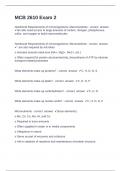MCB 2610 Exam 2
Nutritional Requirements of microorganisms: Macronutrients - correct answer
✔all cells need access to large amounts of carbon, nitrogen, phosphorous,
sulfur, and oxygen to build macromolecules
Nutritional Requirements of microorganisms: Micronutrients - correct answer
✔· are also required by microbes
o Includes several metal ions (NA+, Mg2+, Mn2+, etc.)
o Often required for protein structure/activity, biosynthesis of ATP by electron
transport-related processes
What elements make up proteins? - correct answer ✔C, H, O, N, S
What elements make up lipids? - correct answer ✔C, H, O, P
What elements make up carbohydrates? - correct answer ✔C, H, O
What elements make up nucleic acids? - correct answer ✔C, H, O, N, P
Micronutrients - correct answer ✔(trace elements)
o Mn, Zn, Co, Mo, Ni, and Cu
o Required in trace amounts
o Often supplied in water or in media components
o Ubiquitous in nature
o Serve as part of enzymes and cofactors
o Aid in catalysis of reactions and maintenance of protein structure
,Some organisms also require unique substances such as
_________________ used to construct _____________________ - correct
answer ✔silicic acid
silica walls of diatoms
No matter what an organism's nutrient requirement they require a
____________________ - correct answer ✔balanced mix
What happens to a microorganism if one nutrient is limited or in short supply?
- correct answer ✔the organism will have limited growth
What is the backbone of all organic components present in a cell? - correct
answer ✔Carbon
Along with carbon, what elements are also found in organic molecules -
correct answer ✔hydrogen and oxygen
Why do organisms need electrons? - correct answer ✔Electrons play a role
in energy production used for cellular work and reduction of Co2 to form
organic molecules
3. Autotrophs - correct answer ✔assimilate carbon from inorganic sources
3. Heterotrophs - correct answer ✔assimilate carbon in preexisting organic
form
,2. Organotrophs - correct answer ✔obtain electrons from organic
compounds
2. Lithotrophs - correct answer ✔use inorganic molecules as a source of
electrons
1. Phototrophs - correct answer ✔capture light energy to produce ATP
1. Chemotrophs - correct answer ✔capture energy from oxidation of reduced
organic or inorganic compounds
To what major nutritional group do you think human microbial pathogens
belong? - correct answer ✔Chemoorganoheterotroph
Can microorganisms change nutritional type? - correct answer ✔- Some
organisms have great metabolic flexibility and alter their metabolism in
response to environmental changes (ex. When oxygen is limiting they can
switch their metabolism to use light as source of energy -> facultative
anaerobe (E. coli)
- This provides distinct advantages to organisms that experience frequent
changes to environmental conditions
Why is Nitrogen an absolute requirement to microorganisms and how is it
supplied? - correct answer ✔o needed to make Amino acids, purines,
pyrimidines, some carbohydrates, lipids, enzyme cofactors, etc.
o Supplied in numerous ways such as metabolism of amino acids, nitrates,
ammonia, and some fix N2 from atmosphere
, Why is Phosphorus an absolute requirement to microorganisms and how is it
supplied? - correct answer ✔o P is needed for nucleic acids, phospholipids,
nucleotides, some cofactors, some proteins, etc
o Usually supplied as inorganic phosphate
- Most organisms use inorganic phosphorus which is directly incorporated into
their cells
Why is Sulfur an absolute requirement to microorganisms and how is it
supplied? - correct answer ✔o Sulfur is needed for amino acids cysteine and
methionine, some carbohydrates, biotin and thiamine
o Usually supplied as sulfate via assimilatory sulfate reduction
- Most organisms use sulfate and reduce it by assimilatory sulfate reduction
Growth Factors - correct answer ✔· Some organisms can synthesize all
organic molecules from a single carbon source and inorganic salts, but some
require growth factors to support growth
· Growth factors are organic compounds that cannot be synthesized by an
organism but are essential for growth
· Must be supplied by the environment if the cell is to survive and reproduce
What is needed to grow E. coli that has a mutation in one of the pathways
leading to its amino acids? - correct answer ✔· Wild type E. coli can
synthesize all of its amino acids, nucleic acids, anything it needs given basic
requirements for carbon and inorganic salts, but if there is a mutation in one of
the pathways leading to its amino acid, this organism would need that amino
acid added as a growth factor to growth medium in order for that
microorganism to grow
Why is it so difficult to grow Myobacterium leprae in lab? - correct answer ✔·
Mycobacterium lepraehas a slow growth rate and we cannot figure out how to
grow in lab as we do not know growth requirements




